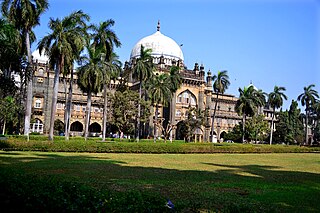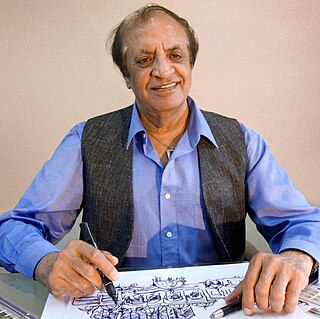
An architect is a person who plans, designs and oversees the construction of buildings. To practice architecture means to provide services in connection with the design of buildings and the space within the site surrounding the buildings that have human occupancy or use as their principal purpose. Etymologically, the term architect derives from the Latin architectus, which derives from the Greek, i.e., chief builder.

Landscape architecture is the design of outdoor areas, landmarks, and structures to achieve environmental, social-behavioural, or aesthetic outcomes. It involves the systematic design and general engineering of various structures for construction and human use, investigation of existing social, ecological, and soil conditions and processes in the landscape, and the design of other interventions that will produce desired outcomes.

Morarji Ranchhodji Desai was an Indian independence activist and politician who served as the 4th Prime Minister of India between 1977 and 1979 leading the government formed by the Janata Party. During his long career in politics, he held many important posts in government such as Chief Minister of Bombay State, Home Minister, Finance Minister and 2nd Deputy Prime Minister of India.

Chhatrapati Shivaji Maharaj Vastu Sangrahalaya, (CSMVS) originally named Prince of Wales Museum of Western India, is a museum in Mumbai (Bombay) which documents the history of India from prehistoric to modern times.

George Mathew Fernandes was an Indian trade unionist, statesman, and journalist, who served as the 22nd Defence Minister of India from 1998 until 2004. He was a member of Lok Sabha for over 30 years, starting from Bombay in 1967 till 2009 mostly representing constituencies from Bihar. He was a key member of the Janata Dal and the founder of the Samata Party, now led by Uday Mandal its President. He held several ministerial portfolios including communication, industry, railways, and defence. In 2020, he was posthumously awarded the Padma Vibhushan, India's second highest civilian award.

The American Institute of Architects (AIA) is a professional organization for architects in the United States. It is headquartered in Washington, D.C. AIA offers education, government advocacy, community redevelopment, and public outreach programs, and collaborates with other stakeholders in the design and construction industries.
The Grant Government Medical College is a public medical college located in Mumbai, India. It is affiliated to the Maharashtra University of Health Sciences. Founded in 1845, it is one of the oldest medical colleges in South Asia. Its clinical affiliate is Sir J.J. Group of Hospitals, a conglomerate of four hospitals in South Mumbai including Sir J.J. Hospital, St George Hospital, Gokuldas Tejpal Hospital and Cama and Albless Hospital.

The American Institute of Architecture Students (AIAS) is an independent, nonprofit, student-run organization that offers programs, information, and resources critical to architectural education. It primarily serves about 25,000 architecture students enrolled in accredited U.S. collegiate programs each year. Recently, the AIAS has also expanded its reach to international academic programs.

Sooni Taraporevala is an Indian screenwriter, photographer, and filmmaker who is the screenwriter of Mississippi Masala, The Namesake and Oscar-nominated Salaam Bombay!, all directed by Mira Nair. She also adapted Rohinton Mistry's novel Such A Long Journey and wrote the films Dr. Babasaheb Ambedkar, her directorial debut Little Zizou, and Yeh Ballet, a Netflix original film that she wrote and directed.
George Wittet (1878-1926) was a Scottish architect who worked mostly in Mumbai, India.

The Sir Jamsetjee Jeejeebhoy School of Art is the oldest art institution in Mumbai, India, and is affiliated with the University of Mumbai. The school grants bachelor's (B.F.A) degrees in Painting, ceramic, Metal work, Interior decoration, Textile design and Sculpture as well as Master's degrees (M.F.A) in Portraiture, Creative Painting, Murals, Sculpture, and Printmaking.

Claude Batley F.R.I.B.A., F.I.A.A., was an English architect who as practitioner, teacher and President of the Indian Institute of Architects from 1921 to 1923, played an influential role in development of modern architecture in India in the first half of the 20th century.

The Landscape Institute (LI) is a UK based professional body for the landscape profession. Its membership includes landscape architects, urban designers, landscape planners, landscape scientists and landscape managers. The LI also has a category for academic members.

The Municipal Corporation Building, Mumbai, located in South Mumbai, Maharashtra, India is a Grade IIA heritage building opposite to the Chhatrapati Shivaji Terminus at the junction of Dadabhai Naoroji Road and Mahapalika Marg. It is also known as the BrihanMumbai Municipal Corporation Building, or BMC building for short.

The Medical Council of India (MCI) was a statutory body for establishing uniform and high standards of medical education in India until its dissolution on 25 September 2020 when it was replaced by National Medical Commission. The Council granted recognition of medical qualifications, gave accreditation to medical schools, granted registration to medical practitioners, and monitored medical practice in India. The MCI faced persistent criticism for corruption.

Sir J. J. College of Architecture is an architecture school located in downtown Mumbai (Bombay), affiliated to University of Mumbai in the state of Maharashtra, India. Sharing its premises with Sir J. J. School of Art and Sir J.J. School of Applied Art, it is now rented from Government of Maharashtra as per the deed of Sir Jamsetjee Jejeebhoy. The college occupies two buildings, housing the teaching and non teaching departments along with a small workshop area and canteen space. The Old Building is one of the heritage buildings in the campus.

Krishnarao Jaisim is an architect and the former chairman of the Indian Institute of Architects, Karnataka Chapter. His work has been featured in The New York Times, The Hindu, The Times of India, The Deccan Herald, and on HGTV.

Ashok H. Desai was an Indian lawyer, practising in the Supreme Court of India. He held office as the Attorney General of India from 9 July 1996 to 6 May 1998. Earlier, he was the Solicitor General of India from 18 December 1989 to 2 December 1990. He was awarded the Padma Bhushan award and the Law Luminary Award in 2001. He was given an honorary doctorate in "recognition of his contribution to the field of law and jurisprudence" by the North Orissa University in September 2009.

Anupama Kundoo is an Indian architect.

Prem Nath is an Indian architect with a wide spectrum of work.


















